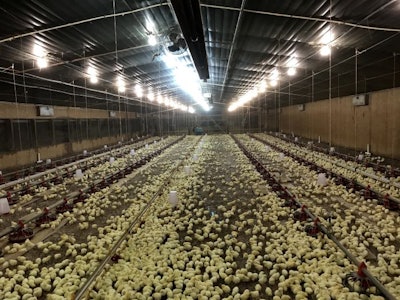
The production of a viable chick requires the successful union of the egg and sperm. The production of settable eggs is accomplished through sound management practices designed to support breeder hen flock uniformity and on-track bodyweight and fleshing. The same management principles must apply to males if there is any expectation of producing fertile, settable eggs. Most of the management focus is on pullets. However, the male is often responsible for fertilizing eggs from 10 or more hens.

Jim Jones | Cobb-Vantress
Male fertility is established in the rearing house rather than production house. Therefore, as with pullets, growth, condition/fleshing, and uniformity must be closely managed. This requires following the recommended growth and feed charts provided in our product supplements. Flock uniformity is a composite of genetic and environmental influences. Flock managers are responsible for the environment and must manage the environment to reach the full genetic potential of the flock.
The process begins in the hatchery with the production of high-quality day-old chicks. Ideally, the flock should be sourced from as few flocks as possible. This generally results in a more uniform chick size and quality. Day-old chick quality, combined with optimum brooding conditions, is essential to getting the best start possible for the flock.
A poor chick start will negatively impact flock uniformity during the first week post-hatch and is difficult to correct. It is imperative that the farm is ready prior to chick placement. Monitor environmental conditions 24 hours before chick arrival to ensure that ideal house and floor temperature, air quality, light intensity, and feed and water conditions are achieved. It is essential that the house contain sufficient floor, water, and feeder space to meet weekly requirements that provide all males with equal access to feed and water.
Male frame size is largely determined at an early age with 90% of frame development complete by 12 weeks of age. Progress in skeletal development may be evaluated based on achieving a minimum of 135 millimeter for shank length by 12 weeks. This is important because the first 12 weeks integrates the brooding and maintenance period where feed intake is limited to reduce the propensity for rapid growth. It is during this time that small weekly feed increases in the range of 1 to 2 grams per week. The objective of this period is to provide sufficient feed to achieve the weekly bodyweight target and not exceed or go below the standard by 5% or more. It is very important for males to be at target weight by 14 to 15 weeks of age as the flock approaches puberty. To maximize the genetic potential for fertility-related traits, never allow males to lose or stall in weight gain during rearing.
In many regions of the world, flocks are often graded several times by bodyweight and segregated into different weight classifications (heavy, average, small). Feed increments are adjusted accordingly for each group with the objective of realigning the bodyweight to the standard weight recommendation no later than 12 weeks of age. Flocks are typically graded at 1, 4, and 8 weeks post-hatch. If a single grading is done, the ideal age is between 3 and 4 weeks. Be aware that it is possible for a flock to be on target for bodyweight but lack uniformity.

Examples of uniformity curves. In the top curve, the weights are very similar among the birds in the uniform flock. In the bottom curve, uniformity is poor and the weights of the birds are widely variable among the population. (Courtesy Cobb-Vantress)
Additional gradings after 12 weeks of age should shift importance from bodyweight to uniform breast muscle development. The goal is to have more than 95% of the males correctly conditioned by 20 weeks of age.
Males that do not meet quality standards and have physical defects or extremely low bodyweights should be removed from the flock. If a sufficient number of males are available, it is recommended that during the 4-week grading, 10% of the lightest males be removed. This will help reestablish uniformity and allow focus to be placed on those birds that have the best chance of achieving high fertility. Birds with physical defects should be removed for obvious welfare concerns but also to ensure that defects are not passed to broiler offspring.
As males approach sexual maturity, the feed allocation increase is accelerated (4 to 5 grams per week). The extra feed during this time supports the development of secondary sex characteristics including testicular development in preparation for photostimulation. It is important that males do not gain excessive weight during photostimulation as it will lead to balance issues when mounting and a reduction in mating completions.
Fertility is a trait that is expressed in the production house but is clearly defined by management decisions in the rearing house. It starts with good-quality chicks receiving a uniform brood environment. It is important to adhere to bodyweight recommendations while also establishing and maintaining flock uniformity. I always tell my customers to take time to stop and think about what they are doing when rearing males. Why are we getting the results we are getting? What management/environmental adjustments can be made in the rearing house to improve flock fertility in the production house? Finally, and most importantly, take action to implement positive change for future flocks.

















